Suzuki DR650 Shift Levers
Not all DR650 shift levers are created equal!
Who thinks about shift levers? Not me.
If you added up all the time I have spent thinking about this subject over the course of my entire motorcycle career — which spans more decades than I care to think about — you wouldn’t have enough time to tie your shoes.
That all changed suddenly one day…
Soon after I bought the used DR650, I happened to notice that the tip of the shift lever was cracked.
Further inspection revealed scratches in the engine case — a sure sign of a tip-over.
This happened in the hands of the previous owner and I’d bet a doughnut that it had something to do with the deployment of the side stand. I see no other signs of damage on the bike that would indicate a high-speed crash.
So what to do? If I had a shop welder — and one of these days I will — I would have cobbed together a fix.
But, since I was placing an order for more DR650 goodies anyway, I added a new Emgo shift lever to the cart.
I thought this would be a simple fix; after all, a shift lever is a shift lever is a shift lever, right? Turns out, it’s not as simple as it appears.
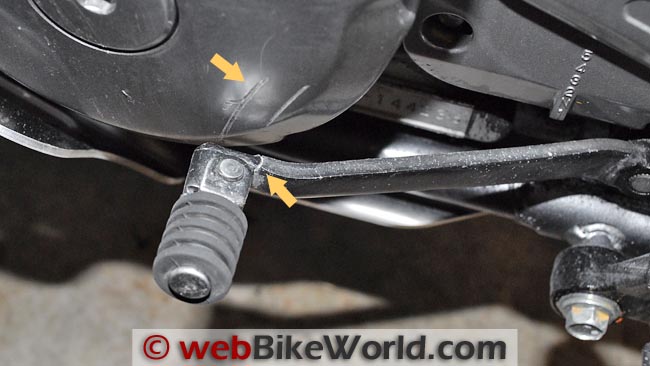
Where to Buy Suzuki DR650 Shift Lever
Check Reviews & Prices on AmazonSee More: Motorcycle Accessories, Motorcycle Tire, Motorcycle Helmets
Removing the Suzuki DR650 Shift Lever
The Emgo shift lever arrived, so it was time to get to work. I quickly discovered that in the end, it’s easier to remove the plastic cover that hides the front sprocket on the DR650.
This is easily accomplished but be careful, because you dn’t need much torque on those bolts.
The DR650 shift lever is held on a spline on the left side of the engine. The shift levers have a matching split spline and after the shift lever is placed on the spline, a threaded bolt is tightened to hold the lever in place.
The spline that comes out of the transmission also has a groove cut into it, which provides the clearance for the side of the bolt on the shift lever spline and keeps the shift lever in place.
Removing the shift lever is very easy; simply loosen and remove the bolt and slide the shift lever off the spline. But before you remove it, make a note or take a photo and take some measurements to mark the location of the shift lever tip.
This will help to make sure you get the replacement located correctly.
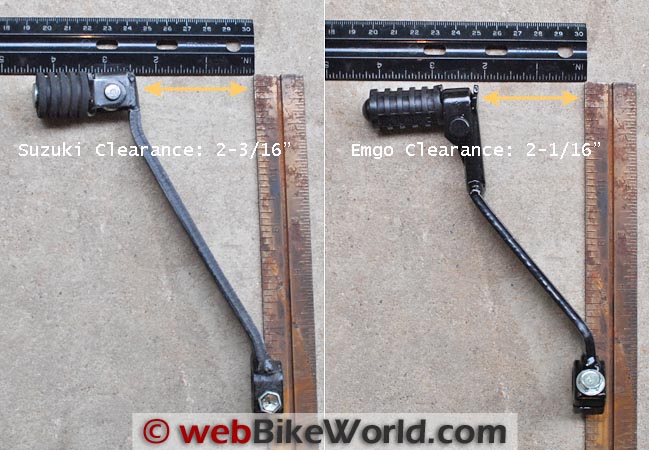
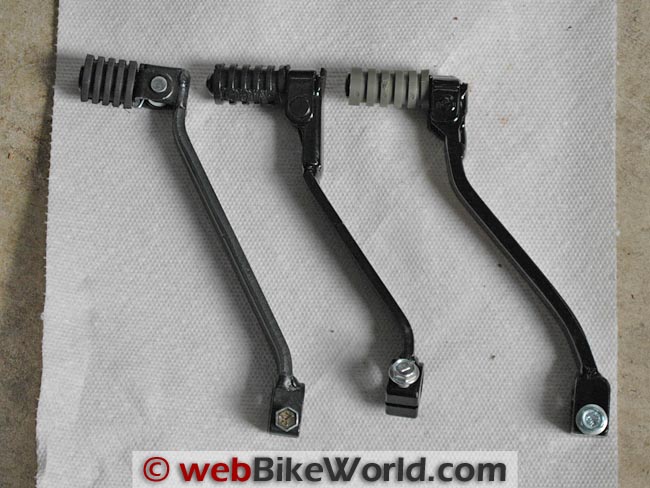
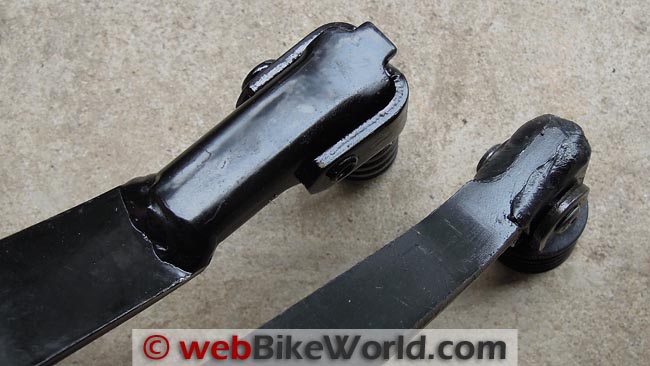
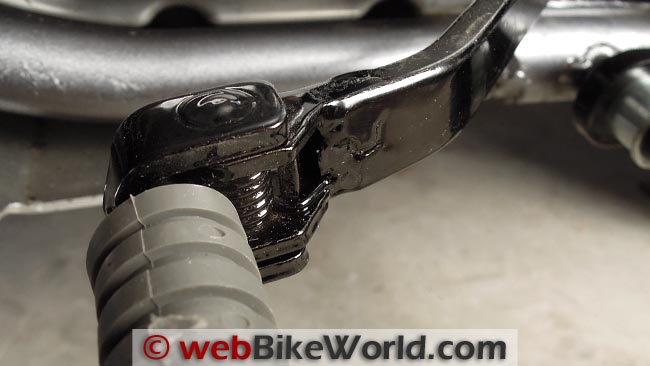
Where to Buy Suzuki DR650 Shift Lever
Check Reviews & Prices on AmazonSee More: Motorcycle Accessories, Motorcycle Tire, Motorcycle Helmets
Suzuki DR650 Shift Levers: Suzuki vs. Emgo vs. Moose Racing
When I installed the Emgo shift lever on the spline, I discovered two problems. First of all, the spline on the Emgo lever I received is offset, which gives it a much different orientation on the bike than the stock lever.
Then, I discovered that the Emgo shift lever did not have enough “reach” to clear the engine case.
Measuring from the centerline of the spline on the shift lever to the back of the shift lever tip, the standard Suzuki lever has 55.5 mm (2-3/16″) clearance, while the Emgo lever has 52.4 mm (2-1/16″) clearance.
That’s just enough of a difference to make the Pro Cycle shift lever fit correctly.
There wasn’t enough clearance over the case, and this was before I installed the engine case guards (review), which add another couple of millimeters of reach that is required.
Note that the clearance issues will depend on the orientation of the shift lever on your bike. If the shift lever tip is pointed further down at an angle, you may find that you’ll have enough clearance with the Pro Cycle shift lever.
After scratching my head for a while, I pulled the Emgo shift lever off and took a ride over to the Suzuki dealer and bought a new Suzuki replacement lever.
Not long afterwards, in a coincidental email with Bill Eakins from Butler Maps, Bill suggested the Moose Racing shift lever, which he has installed on his DR650.
Moose Racing lists two shift levers for the DR650: Part number MSU11 for the 1991-1993 years and part number MSU16 for 1994 through 2009.
I don’t think there’s a difference from 2009 and beyond, but I don’t know that for sure.
The Moose Racing shift lever is noticeably “beefier” than either the stock Suzuki lever or the Emgo lever.
It’s made from 7.5 mm thick sheet steel (0.3″), which is about 30% thicker than either the stock Suzuki shift lever at 5.8 mm (0.231) thick or the Emgo shift lever at 5 mm (0.20″) thick.
The Moose lever has a longer reach (i.e., more clearance over the engine case), but I didn’t measure it before I installed it, unfortunately.
It also has a more curved shape, which could help reduce stress fractures over the angular bends on the other shift levers.
It also has a “beefier” looking tip, with a different configuration for the folding mechanism. It’s obvious from looking at the photos of the shift lever tips above that the stock Suzuki shift lever was made with low cost in mind.
The Emgo tip is welded on the end of the lever, a potential breaking point.
The tip of the Moose Racing shift lever is also welded on, but the entire assembly has a much higher level of quality and the steel is thicker.
I have since installed the lowered foot pegs and SW-Motech center stand on the DR650 and I’ll report on those soon. The Moose Racing shift lever works perfectly fine with the lowered foot pegs after I moved it down a notch or two on the shifter spline.
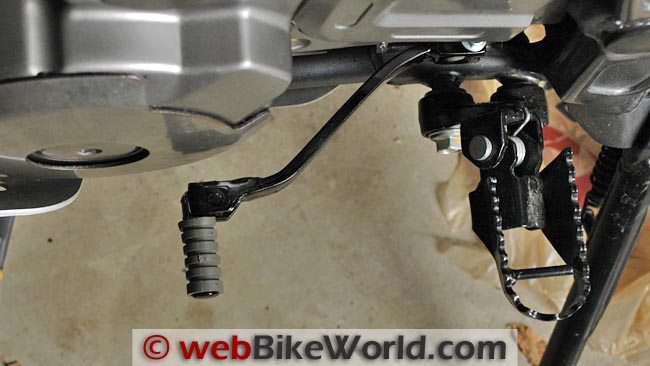
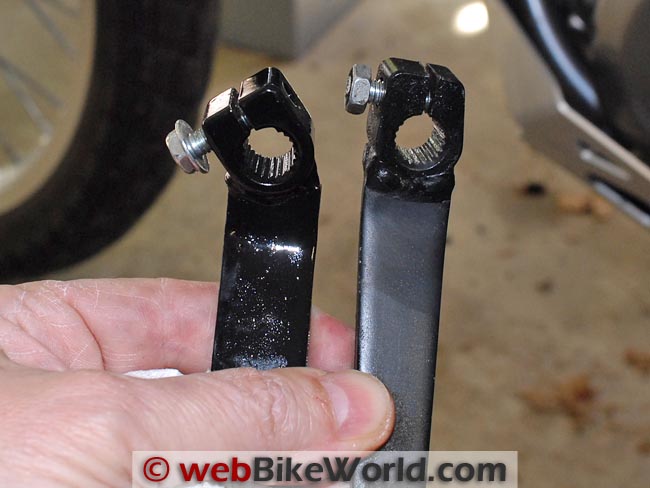
Conclusion
The Moose Racing shift lever is heavier and fits perfectly on the DR650. Too bad I hadn’t talked to Bill Eakins before I spent all this time and money on something as simple as a shift lever!
I wasn’t able to find many DR650 shift lever options, so if anyone has a suggestion, let me know.
More: DR650 Rear Master Cylinder Guard Review and Installation
The wBW DR650 Blog
| wBW Review: Moose Racing DR650 Shift Lever | |
|---|---|
| Manufacturer: Moose Racing | List Price: $29.95 USD. |
| Colors: Black. | Made In: Unknown |
| Review Date: January 2012 | |
Where to Buy Suzuki DR650 Shift Lever
Check Reviews & Prices on AmazonSee More: Motorcycle Accessories, Motorcycle Tire, Motorcycle Helmets
Owner Comments and Feedback
See details on submitting comments.
From “T.B.” (July 2016): “I do not have direct experience with a Moose Racing shift lever on a DR650, but I did put one on my 1994 DRS350.
The improvement in shifting was dramatic.
Considering that both the original and the Moose Racing one have the same basic design, it’s kind of hard to imagine that “upgrading” such a lever would improve anything. Nothing could be further from the truth.
The Moose Racing lever shifted more cleanly and consistently with better feel and less effort. Amazing.”

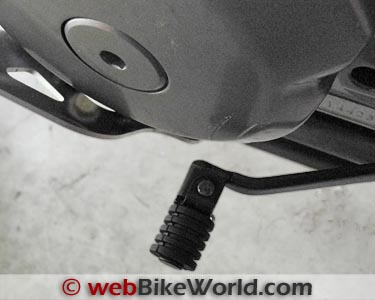

No Comment